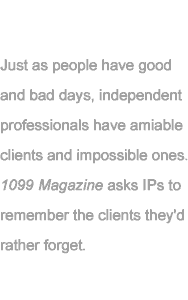 |
|
||||||||||||
 |
|
||||||||||||

|

|
|
By Dennis Barker
-- Tom Cooper, independent publishing consultant |
The big client, menacing, stands up like De Niro in the baseball bat scene from The Untouchables. He walks down to the end of the conference table, where the consultant sits twitching nervously, and picks up a glass pitcher filled with ice water. Then he dumps it on the consultant's head. "Your proposal is the most lame-brained idea I've ever heard," the client says. "Get out." Fortunately, this never happened, and isn't likely to: even moody clients don't usually unload gangster-style. No, bad clients aggravate IPs in other ways: with late payments, non-payments, lack of focus, and freakish spasms of hyper-control. The most difficult client, the one that can make the corporate cubicle look downright utopian, has to be the nonpaying client, followed closely by the slow-paying client. Most bad-client situations merely ruffle your feathers, tarnish your ego -- but these types threaten your business. Pam Watson, a marketing strategist who's been an IP for more than three years, says her absolute worst problem-client was a big company that wouldn't pony up. As if tardy payment weren't bad enough, Watson had been paying vendors for expensive services on the client's behalf. "I got on a plane and went out and saw them," Watson recalls. "I needed to see them face to face. I sat down with them and they agreed and apologized and still didn't pay. This situation went on for about five months - really, really difficult. It put my business in a bind. They were happy with the work, but I was dealing with someone who was not a good manager. She got my invoices and put them in a pending file. It finally got to the point where I said, 'I can't work for you unless you pay up front.'" What's Watson's advice for dealing with delinquents? "Put procedures in place. Because that's what they need." If that doesn't work, maybe it's time for a face-to-face meeting. Next is the client who wants free advice. This is often an acquaintance or "friend." Bob Pettegrew, a marketing and sales consultant, knew a guy who had his own business and needed help improving his marketing strategy. They had several meetings to develop plans. Then they had some more meetings. "He would call me up at 8 p.m. and say, 'Let's meet for coffee and talk,'" Pettegrew recalls. "Well, this went on for two or three months. Being newly out on my own, I was afraid to cut it off. But finally I sent him a bill. He called and said he was 'shocked.' He was totally indignant. Ultimately he sent me a check for about a fifth of what the invoice was for." Now Pettegrew tells clients at the first meeting that the clock is ticking. Mark Twain Trumps a Power PlayKen Richters, a self-described member of "the growing ranks of the self-unemployed," is a professional actor who does TV commercials, voice-overs, and speech coaching. He frequently portrays Mark Twain. Hired to speak as Twain at a Fortune 500 corporation's national convention, Richters arrived to find out that the company's meeting planner was not happy that Twain was on the program. Twain's after-banquet appearance had been suggested by a senior executive, but the meeting planner still didn't think it was a good idea. "During the dinner," Richters recalls, "the meeting planner called me aside and told me the night seemed to be running long, that he decided to change the program. Rather than close the evening with a 40-minute address, I would speak before the chairman did, for no more than 15 minutes. A classic power play." The meeting planner whispered his program change into the chairman's ear and handed a note to the master of ceremonies. "Twain" spoke for 15 minutes. "The audience laughed - a lot," Richters says. "They laughed more than usual because the rest of the program that night had been dry and boring." The chairman came on next, and spoke for about ten minutes. "Then, without warning," says Richters, "he looked at the audience and said, 'Is anyone as bored with me as I am?' He asked if Mark Twain might get up and say a few more words. I did another 20 minutes, followed by a five-minute standing ovation." Richters says he has learned to deal with such power clashes. "Ten years ago I would have complained. Ten years ago I would have felt the need to show the meeting planner that he was making a mistake. Ten years ago I would have ignored his instructions, given my original address of 40 minutes, and shown the meeting planner who was in charge. Ten years ago I was a jerk." Even Though You're the Expert, I'll Tell You How to Do ItTom Cooper, a publishing consultant specializing in magazine circulation, says his toughest client was a publisher who turned out to be a control freak. The publisher -- "Mr. P." -- wanted to attract more readers to his magazine. To this end, Cooper was supposed to create promotional material to send to prospective subscribers. Unfortunately, Mr. P "had very limited circulation experience yet very definite ideas on how it should be done," Cooper says. "I took the assignment because I figured once we began the process, he would realize the arcane nature of circulation and I would be given the freedom and authority to get the job done. I expect my clients to have involvement in the central message and correctness of the copy, but to leave it to me to handle the packaging of the message." Mr. P., however, granted little freedom. Before long, he made a big issue of a semantical nuance in the promotional copy and insisted that Cooper have it reprinted at no extra charge. Then Mr. P. refused to pay for the original printing -- and Cooper ate the cost. Five months later, Mr. P. decided to change the terms of the original
agreement by reducing Cooper's compensation and the scope of his involvement.
Next, Mr. P. announced he would hire a circulation person for Cooper
to train. At this point, Cooper says, he deemed the relationship beyond
salvage and invoked the termination clause. "If this publisher had had
a proper understanding of how to work with a consultant, he would have
known he was buying expertise, not a temporary employee. The need to
be in total control will always make it difficult for him to work with
independent people." In the end, Mr. P. lost his consultant, but Cooper
regained his freedom. |
||||
| |||||
|
June 1, 1999 Edited by Eric Gershon Illustration by Lawrence San Production by Keith Gendel |
We'd love to hear your comments about this article! Dennis Barker is a freelance writer who lives in Peterborough, NH. If you like, we'd be happy to put you in touch with him, or with any of the other IPs named in this article. | ||||
| |||||